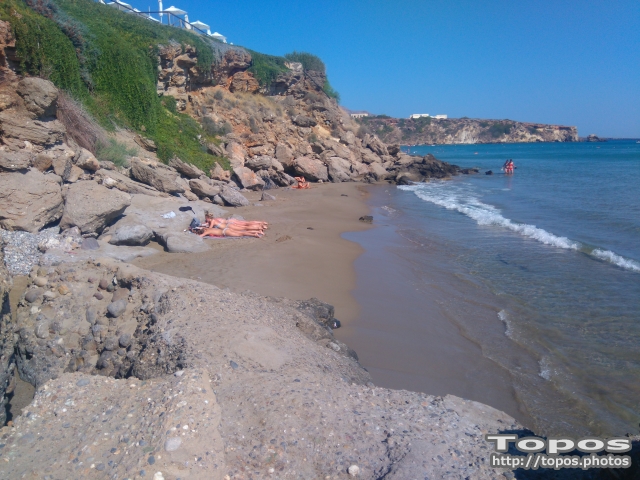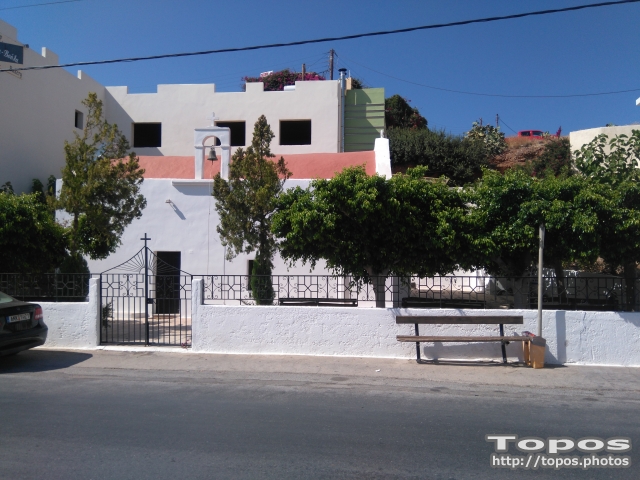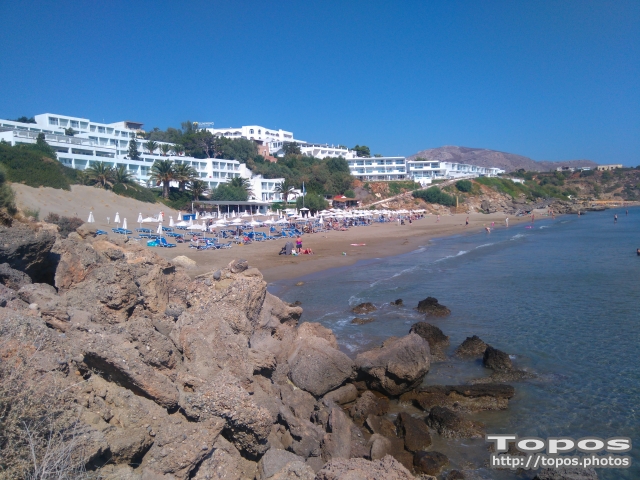Your Position:
Unknown
Λεπτομέρειες ΕικόναςImage details
More Photos
Press here.
Prospilia
Prefecture: Lassithi
, Suggest
, Suggest
Your Opinion

If you want to tell us your opinion about this place, please leave a comment
Post a Comment:
Prospilia
Prospilia is a relatively new settlement in the area. It is built 500 m north of the seacoast on the road from Analypsis to Pefkoi. The development started in 1970 and is still growing.
The name Prospilia is given to that area as there are many tiny caves of white stones. Prospilia, ASprospilia, Aspra Spilea (White Caves) is the conversion of the words describing the characteristics of the area.
Πηγή:
«Πεύκοι “Τόπος και Ιστορία”», Γεωργίου Θ. Καναβάκη (Καναβογιώργη), Έκδοση Κοινότητας Πεύκων, Ιούλιος – Αύγουστος 1994
Places near Prospilia
Pilalimata is an old small village south of Pefkoi, a continuance of Analypsi, which is on the way to Sitia and about 1000m far from the seacoast, the beaches of Diaskari and Lagkadas.According to tradition its legacy started prior to the sovereignty of the Turks; yet it is not known for a fact who founded the village. In line again with tradition it is widely believed that the Byzantines have seized large territories of land that was occupied by Saracens and built northeast of Pilalimata the great monastery of Kera Panagia (Virgin Mary). Following native population built a metochi (Monastery Dependency) 350m away from the Abbey, where they produced livestock and cultivated land for living. During the Venetian rule it is said that a large number of the region’s properties and part of the monastery was granted to Venetian settlers; others say that Pillalimata was built by the Venetians, but after the destruction of the monastery by the Turks in 1941.
The landscape of the village is flat, and the land known for its fruitfulness; that is mainly the reason that this particular estate was always a property of high ranking officials of the conquerors, Byzantines, Venetians and Turks. The greater region of the village is also referred to the Byzantine Loukas Litinas or Lithinas, whose descendants are believed to be the residents of the nearby village "Lithines". Pilalimata was his tsifliki (private estate), and he was left in history as one of the most dreadful tyrants that the region has seen.
It is alleged that the name Pillalimata comes from the word ‘lima’ which means profit or taken from somewhere. It is also said that the village’s name comes from the word ‘limata or pola pila’ (muddy); a product of geological phenomena caused by a nearby river. Others say that the village was named after a Turkish ‘Aga’ (Ruler), whose name was Pilalis. During the Greek Independence war on 1897 the village was destroyed by fire, and four Turks were killed. Residents of Pefkoi collected the debris of three cypresses, and built onto it the temple of the Orthodox church of the Three Hierarchs.
Πηγή:
«Πεύκοι “Τόπος και Ιστορία”», Γεωργίου Θ. Καναβάκη (Καναβογιώργη), Έκδοση Κοινότητας Πεύκων, Ιούλιος – Αύγουστος 1994
On the road that passes from the settlement of Analypsis is built the little church dedicated to the Ascension of Jesus. Its construction began in 1908 from residents of Pefki at a location that had the name “Big piece or Chani”. Its completion was delayed up to 1930, due to the long-lasting wars from 1913 until 1922 and other unfavourable situations. Then a villager, who was retired officer of police force and tradesman in the town of Ierapetra, Charilaos M Manoysakis sponsored its completion which took place in 1933 from the craftsman Stefanos E Karamanolakis from the Krya village. The opening ceremony of the Temple became the 1934. In 1983 suffered damage due to arson, the repair then was sponsored by the ship-owner Antonios Lelakis from the town of Sitia.
Πηγή:
«Πεύκοι “Τόπος και Ιστορία”», Γεωργίου Θ. Καναβάκη (Καναβογιώργη), Έκδοση Κοινότητας Πεύκων, Ιούλιος – Αύγουστος 1994
Church of St George of Samakidis
South-east of the village in a distance of 3,5 kilometres and another so long from the settlement of Analypsis is found the little church of St George which in the past was known as Monastery of Samakidis.
It is built under a cavernal precipice at the point where history reports that there was a hermitage of nuns. Writings regarding the Temple or the monastery have not been found. Probably any writings were disappeared at the long-lasting possession of Turks. Tradition and history report that in 1471 A.D. by the raid of Turks most villages of Sitia province and Abbeys were destroyed. «…»
Πηγή:
«Πεύκοι “Τόπος και Ιστορία”», Γεωργίου Θ. Καναβάκη (Καναβογιώργη), Έκδοση Κοινότητας Πεύκων, Ιούλιος – Αύγουστος 1994
In the early years, Analypsis was a settlement of the former Community of Pefkoi. Its development began in 1956 in the area north of the beach.
Initially the settlement was built east of the port of Makry Gialos but due to the growth, it quickly joined with the settlement of Makry Gialos. Furthermore the area took the name of Makry Gialos and today forms the Municipality of Makry Gialos.
The main reason for the foundation and growth of the settlement was the opening of the road from Ierapetra to Sitia in 1956 and the cultivation of precocious horticultural since 1957.
In 1961 for the first time the area was reported in official documents as Analypsis and the 4th inventory department of Community of Pefkoi. In 1971-72 the development begun and the road network was improved. As a result tourists appeared and small cottages became rooms for rental by tourists, bungalows were built, shops and then the first big hotel which attracted more tourists.
At present permanent residents of Analypsis exceed 2000 while the summer months the population is increased by locals and tourists.
For accommodation, there are plenty of rented rooms, hotels, villas. Furthermore super markets, restaurants, cafes, car rental businesses are present and a lot of relevant shops that can cover visitors’ requirements.
In front of the settlement unfolds the clean and rewarded with the blue flag, sea of Lybikon with the beautiful and spectacular beach of Makry Gialos.
The sea and the sandy beach from the south, the panoramic and green mountains with beautiful slopes from the north, combined with the sun, fresh air of mountains and sea, make the settlement of Analypsis and Makry Gialos in ideal place for holidays.
Miramare Studios - apartments Makrigialos >> sea view apartments in southeast Crete >> Family accommodation in Makrys Gialos CreteMiramare is consisted of eight stylish studios, which are located only a few steps away from the beach, in a very quiet place on the edge of a settlement. The settlement is the picturesque haven of Makris Gialos. In this village, you can find numerous taverns and restaurants, as well as shops, doctors, pharmacy and car rental offices.
Aspros Potamos (White River) is referred to be the oldest settlement of the area of Pefkoi. It is located about 1 km north of the beach of Makry Gialos.
Narrations report that the settlement was wealthy in the past, but because of the close distance from the sea, it was subject to incursions and as a result its residents had to abandon the place and move to the northern areas that were safer for them. It is also reported that the first residents of Pefkoi were the residents of Aspros Potamos. The area can be described as spectacular. The mountains from the North and the valley from the South that reaches the settlement of Analypsis, the stream of Aspros Potamos which crosses the settlement, form a unique landscape.
Most of the old houses of the settlement, which were built from stone and soil, have been refurbished and attract many visitors.
Πηγή:
«Πεύκοι “Τόπος και Ιστορία”», Γεωργίου Θ. Καναβάκη (Καναβογιώργη), Έκδοση Κοινότητας Πεύκων, Ιούλιος – Αύγουστος 1994
Church of St James (St Dimitrios)
In Pilalimata, in the decade of 1980 Mr Georgios Dermitzakis from the village of Lapithos and his spouse Ekaterini Ioannou Chatzakis from Agios Stefanos offered a big part of their land and a respectable amount of money for building the temple of Saint Dimitrios. After their death construction of the temple was carried out by the residents of Pilalimata and others from the nearby areas, with the priest Emmanuel Chatzakis being the organizer of their endeavour. Finally the opening ceremony was held on the 26th-10-1993.
Πηγή:
«Πεύκοι “Τόπος και Ιστορία”», Γεωργίου Θ. Καναβάκη (Καναβογιώργη), Έκδοση Κοινότητας Πεύκων, Ιούλιος – Αύγουστος 1994







